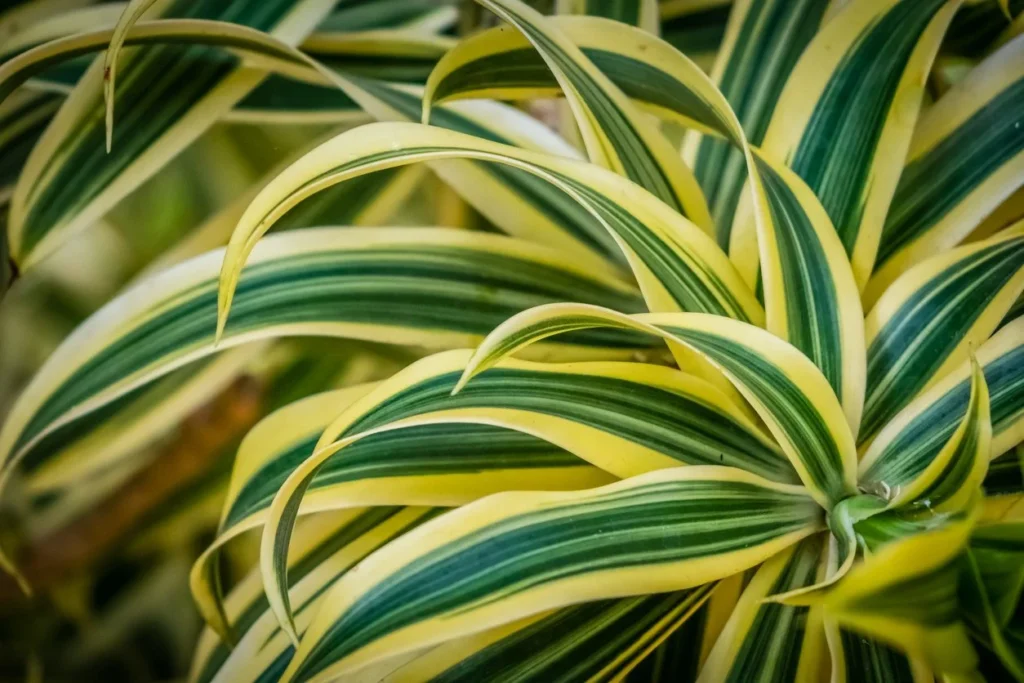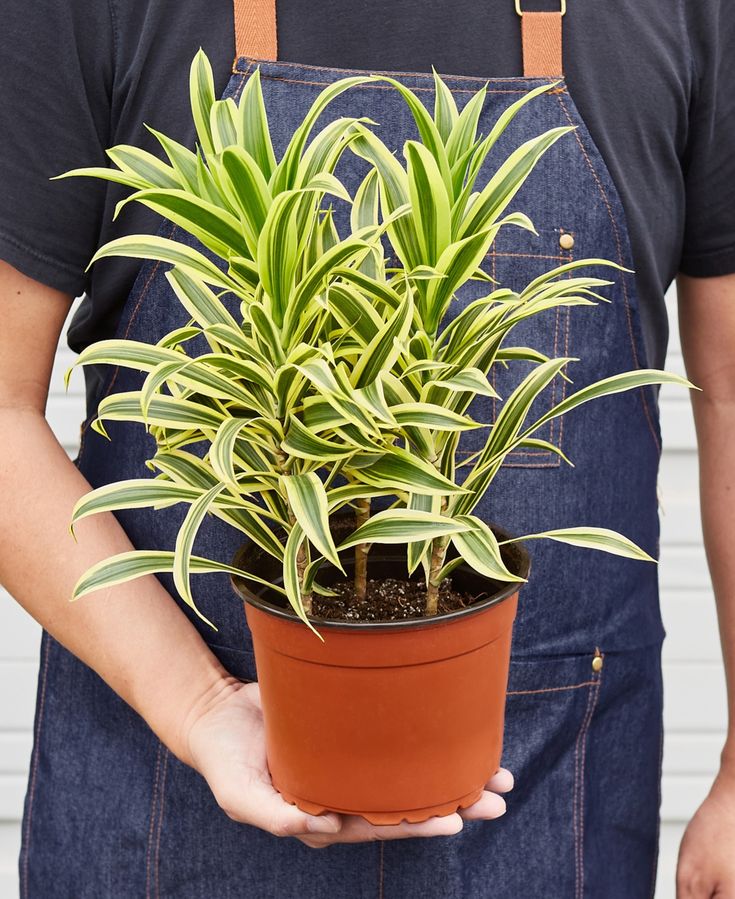Introduction
The Dracaena plant, a beloved houseplant known for its rich green leaves and striking appearance, is a quintessential addition to indoor spaces. When placed with intention, its vibrant foliage can turn any dull room into a lively haven. But what truly makes indoor plant Dracaena stand out, apart from its looks, is its forgiving nature—making it an ideal choice for both novice and experienced plant enthusiasts. This review dives deep into the care and specifics of the Dracaena, ensuring that your plant not only survives but thrives.
Dracaena (Various species) Indoor Plant Details
| Key Specifications | Details |
|---|---|
| Common Names | Dragon Tree, Corn Plant, Lucky Bamboo, Song of India |
| Botanical Name | Dracaena (followed by species name, e.g., Dracaena marginata) |
| Family | Asparagaceae |
| Plant Type | Evergreen perennial |
| Mature Size | Varies by species, usually between 2 to 10 feet indoors |
| Sun Exposure | Bright, indirect light |
| Soil Type | Well-draining potting mix, with some sand or perlite |
| Soil pH | Neutral to slightly acidic (6.0 to 7.5) |
| Bloom Time | Rarely blooms indoors; if it does, it’s usually in late winter or spring |
| Flower Color | Typically white or yellowish, but blooms are rare indoors |
| Hardiness Zones | 10-12 (depends on the specific species) |
| Native Area | Africa, Southern Asia, and Central America |
This table provides a concise snapshot of the Dracaena plant’s key characteristics. By understanding its native habitat and preferred conditions, one can recreate an optimal environment for the plant indoors, ensuring its health and vigor.
 Plant Care
Plant Care
Caring for Dracaena is a delightful journey, one where you’ll witness the plant’s graceful response to your nurturing. Regularly checking its light, soil, and water requirements can ensure a long-lasting relationship with this indoor gem.
Light
Dracaena’s adaptability to various lighting conditions is commendable. While it loves bright, indirect sunlight, it’s also tolerant of lower light conditions. However, avoid exposing it to direct sunlight for prolonged periods as it can burn its leaves. If your Dracaena starts to look leggy or its vibrant color starts to fade, it’s a sign to adjust its light exposure.
Soil
Well-draining soil is the ticket to a healthy Dracaena. A mix of regular potting soil with a bit of sand or perlite works wonders. This combination ensures that the roots get enough air and aren’t sitting in water, preventing root rot.
Water
Watering is where many plant parents either overcommit or neglect. Dracaena prefers its soil to dry out between waterings. Use your finger to check the top inch of soil—if it’s dry, it’s time to water. Remember, it’s better to underwater than overwater; root rot is a real concern for these plants.
Temperature and Humidity
Native to tropical climates, Dracaena thrives in temperatures between 60°F to 75°F. Avoid placing it near drafts, air conditioners, or heaters. It also enjoys humidity, so if you live in a dry area, consider placing a humidifier nearby or misting its leaves occasionally.
Fertilizer
During its growing season (spring and summer), feed Dracaena with a balanced liquid fertilizer once a month. In the dormant months of fall and winter, hold off on the feeding. Like all plants, avoid over-fertilizing as it can harm its growth.
Pruning
Pruning isn’t just about aesthetics; it’s about the plant’s health. Trim the Dracaena to maintain its shape and size. Additionally, remove yellow or brown leaves to ensure the plant redirects its energy to healthier growth.
Overwintering
As a tropical plant, Dracaena doesn’t appreciate cold. If you live in an area with chilly winters, ensure your plant is indoors and away from cold drafts. No extra steps are needed; just ensure it’s warm and cozy!
Propagating Plant
Sharing is caring! Propagating Dracaena is straightforward. Cut a stem off, let it air dry for a day, then place it in water. Once roots appear, plant it in soil. Soon, you’ll have a baby Dracaena to gift or add to your collection.
Quickly Declining
While Dracaena is resilient, it’s not immune to problems. Overwatering, insufficient light, or pests can lead to its decline. Always be observant and act quickly, ensuring it remains in optimal health.
Types of Indoor Plant Dracaena
The genus Dracaena encompasses over 120 different species, each with its own unique charm. Here are a few standout species:
- Dracaena marginata (Dragon Tree): Recognized for its slender, arching leaves with red edges.
- Dracaena fragrans (Corn Plant): It flaunts glossy green leaves and can grow quite tall indoors.
- Dracaena reflexa (Song of India): Showcases light green leaves with yellow or creamy stripes.
- Dracaena sanderiana (Lucky Bamboo): Popular in Feng Shui, it’s believed to bring good luck and fortune.
- Dracaena draco (Dragon Blood Tree): Known for its unique umbrella shape and the red sap it produces.
 Common Pests & Plant Diseases with Solutions
Common Pests & Plant Diseases with Solutions
Even with the best care, Dracaena plants can occasionally succumb to pests and diseases:
- Spider Mites: Tiny pests that suck sap, leaving yellow spots. Solution: Wipe leaves with soapy water and keep humidity high.
- Scale: These are small, round, and flat pests that stick to stems and leaves. Solution: Scrape off gently and apply insecticidal soap.
- Mealybugs: White, cottony pests found in leaf axils and undersides. Solution: Wipe with alcohol-soaked cotton or apply neem oil.
- Leaf Spot: Brown or yellow spots on leaves caused by bacteria or fungi. Solution: Ensure good air circulation, avoid wetting leaves, and trim affected areas.
How to Get Dracaena to Bloom
It’s rare for Dracaena to bloom indoors, but it’s not impossible. Follow these tips to increase chances:
- Mature Plant: Older, well-established plants are more likely to bloom.
- Proper Lighting: Ensure your plant receives adequate, indirect sunlight.
- Right Temperature: Maintain a consistent temperature, avoiding drastic fluctuations.
- Fertilizer: Use a balanced fertilizer during the growing season. Sometimes a slight nutrient stress can induce flowering.
Common Problems with Dracaena
Every plant has its quirks, and Dracaena is no exception:
- Brown Leaf Tips: Often due to fluoride in tap water or low humidity. Use distilled or rainwater and mist occasionally.
- Yellowing Leaves: Can be due to overwatering. Ensure the soil is dry at least an inch down before watering.
- Drooping or Limp Leaves: Usually a sign of overwatering or poor drainage. Check the root system for rot and ensure the pot has proper drainage.
- Leggy Growth: Insufficient light can cause the plant to stretch. Move to a brighter location but avoid direct sunlight.
Conclusion: The Beauty and Resilience of Dracaena
Every plant requires a delicate balance of care, and Dracaena is no exception. With this comprehensive guide, the intricacies of its care become a delightful journey of growth and learning. By understanding its needs and potential issues, you pave the way for a thriving, long-lasting relationship with this captivating plant.
Key Takeaways
Caring for a Dracaena is more than just a hobby—it’s a relationship. With a bit of attention to its needs, your Dracaena will continue to grow, bringing a touch of the tropics to your indoor space. Embrace the journey and cherish the vibrant ambiance it adds to your home.
Conclusion: Embrace the journey with Dracaena. With a little care and love, this plant will not only adorn your space but also become a cherished part of your indoor family.
Indoor Plant Dracaena
Frequently Asked Questions
Decode the magic of gardens with our guide to Landscaping Styles Frequently Asked Questions.
- This is often a sign of low humidity or fluoride in tap water. Use distilled water and increase humidity around the plant.
- While primarily an indoor plant, Dracaena can grow outdoors in zones 10-12, where there’s no risk of frost.
- Yes, but ensure it’s protected from direct sunlight and extreme weather conditions.
- While great for humans, Aloe Vera can be toxic to cats and dogs if ingested.
Recent Posts
- Modern Mural Ideas Transforming Walls into Artworks
- Thematic Table Decor Dressing Your Table for Special Occasions
- Festive Lighting Ideas Brightening Your Home for the Holidays
- Biodegradable Decor Materials Choosing Earth-Friendly Options
- Personalized Space Decor Making Your Home Uniquely Yours
- New Year’s Eve Decor Ringing in the New Year in Style
- Transforming Junk into Decor Upcycling at Its Best
- Second-Life Decor Objects Giving Old Items New Purpose
- Unique Decoration Crafting Standout Ideas for Your Home
- Environmentally Friendly Styling Decor with a Conscience











